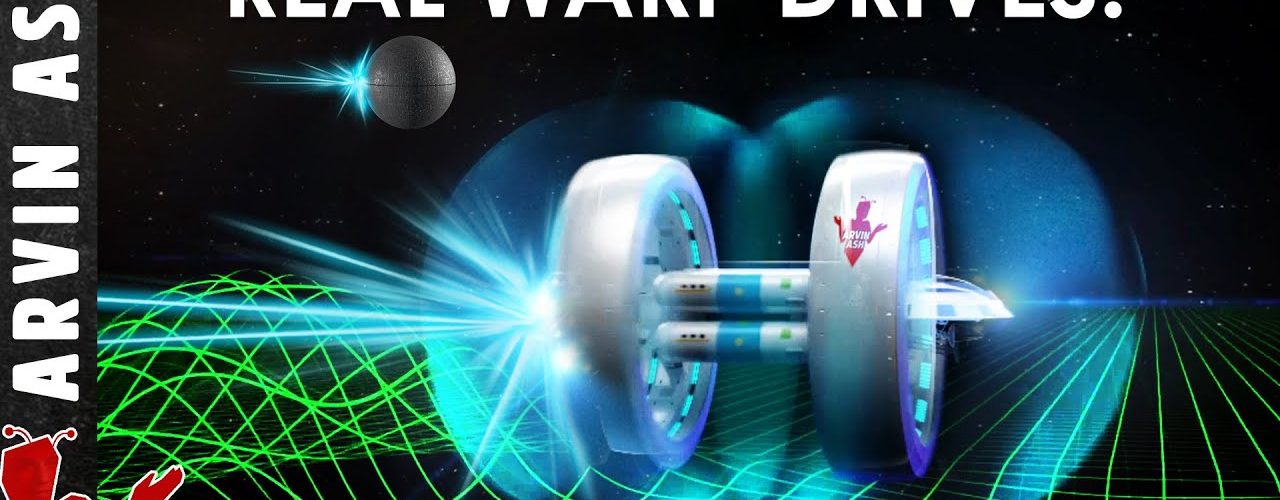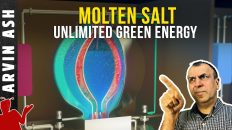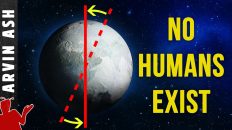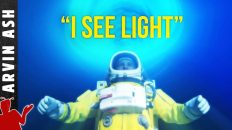The speed of light is the cosmic speed limit of the universe. It is the fastest speed at which any two points in space can communicate with each other. It’s pretty fast relative to our human scales. In just one second, a beam of light would go around the earth…almost 8 times.
But the distances in space are so vast, that even this maximum speed would be is excruciatingly slow for interstellar travel. To visit the planets around even the nearest star, Proxima Centauri, would take over 4 years.
And to go to some of the potentially life supporting exoplanets we have found recently, even at the speed of light, it would take hundreds or thousands of years.
Do we have to just accept that we humans are forever confined to our own solar system?
In Star Trek, captains Kirk and Picard easily travelled to distant star systems in hours using warp drives that allowed them to travel hundreds to thousands of times faster than the speed of light.
If we could create even a modest warp drive, that could allow us to travel say 5 times the speed of light, we could get to Proxima Centauri in about 1 year. This is only a few months longer than a trip to mars would take using today’s conventional technology, and so may be doable.
In a paper published in 1994, Mexican physicist Miguel Alcubierre showed, at least theoretically, that such a warp drive could actually work within the known laws of physics. But in order for it to work, this theoretical drive would require huge amounts of negative mass or energy. Such a thing does not exist. So although it is a good mathematical exercise, it is physically meaningless.
Is there any hope for a physically feasible warp drive, or is the final frontier of Star Trek just the stuff of childhood fantasy? There may be hope because in a recent paper published by the advanced Propulsion Laboratory at Applied Physics, authors Alexey Bobrick and Gianni Martire, outline how a physically feasible warp drive could in principle, work, without the need for negative energy, allowing us to go to neighboring stars.
I spoke to Alexey and Gianni, and in this video, I’m going to show you how such a physically realistic spaceship would work, and what it could look like? If you are an obsessive Trekkie like me, you don’t want to miss what’s coming up right now…
To understand how these drives work, let’s do a quick review of the theory of general relativity – because anything we do at high speeds in spacetime will be defined by this theory. It was published in 1915 by Albert Einstein, and it explains gravity not as a force, but as a curvature in the fabric of space and time, or spacetime.
I’ve made a couple of videos about this, so check them out if you want a more detailed understanding of it. But, here’s a quick recap of what the math of this theory says. The main equation looks like this:
On the left-hand side, the R and g components describe the curvature of spacetime. On the right-hand side we have a bunch of constants including Newton’s gravitational constant, G and the speed of light, C, which don’t change, multiplied by T. This is the Stress-energy tensor. This describes all the matter and energy that causes the curvature on the left side.
What Alcubierre did in his paper is figure out a shape that he believed spacetime needed to have in order for a ship to travel faster than light. He determined that the ship needed to stay inside a flat spacetime bubble, but this bubble of spacetime had to be such that it could move at any arbitrary speed.
Then he solved the right side of the equation to determine what the corresponding matter and energy he would need to generate the desired curvature that he envisioned. And it looked something like this. Keep in mind this is just a 2D representation of 3D curvature. This curvature has stationary bubble in the center, but spacetime contracts in front of the bubble and expands in back of the bubble.
So Alcubierre found a solution that could carry real passengers in this stationary bubble, if the spacetime around it was shaped like this. The problem is that the solution to this curvature required negative mass or negative energy in the Stress-energy portion of the equation.
His solution is mathematically consistent, but negative mass is not known to exist.
Note that negative mass is not the same as anti-matter. Antimatter is like regular matter but with opposite charge. It has positive mass. So while Alcubierre’s solution works mathematically, it is not a physically meaningful solution.
Bobrick and Martire looked more deeply into Alcubierre’s solution, and came up with deeper insights about warp drives, and potential solutions that are physically realistic.
One of the things they PROVED for example is that when you bend spacetime the way Alcubierre did in his solution, even if you have all the negative mass you need, it does not mean that the spaceship in the center will automatically start traveling at high speeds. You still need energy of some sort to make the spaceship move. In other words, the spaceship doesn’t just automatically start accelerating to high speeds just because the spacetime around it is shaped this way.
Some momentum exchange, vaguely similar to conventional rocket technology, is needed, where the momentum of the gasses coming out of the rocket engine in one direction pushes the rocket in the opposite direction. Of course, rocket engines would not work for acceleration that took you close to the speed of light. So some other technology would be needed.
The other thing that Bobrick and Martire showed is that you could potentially travel a significant fraction of the speed of light, but in order to travel faster than the speed of light, or superluminally, you would need superluminal matter. In other words, you would need matter that travels faster than the speed of light. Accelerating anything with mass to the speed of light, let alone beyond, requires an infinite amount of energy. This would be true for any warp engine design, and is a physical impossibility that cannot be achieved.
So, with this seemingly severe limitation, how do they propose that we can still travel to distant stars?
Let’s remember that the idea of the Alcubierre warp drive is to encapsulate a bit of spacetime creating a sort of bubble. A passenger would be in a ship inside this bubble of space time. The ship itself would not be moving relative to the spacetime so there would be no time dilation for people inside the ship.
But this bubble of spacetime could in theory be moving at any arbitrary speed relative to the spacetime around it.
This is analogous to a person on a surfboard. The person is standing still relative to the surfboard, but the surfboard is moving relative to the sea around it.
Since, the ship can theoretically move many times the speed of light, it could get to very far away destinations, like Proxima Centauri, which is 4.2 light years away, for example in 10 months traveling 5 times the speed of light.
But as we learned, no ship can physically travel faster than light, because there is no superluminal matter. The Alcubierre warp drive is science, but it’s also fiction.
What Bobrick and Martire figured out is that there is more than one way to skin a cat.
There is more than one type of warp drive. They actually made 4 classifications of warp drives. These classes are based on the speed inside the bubble and speed outside the bubble, represented by V(in) and V(out). The Alcubierre solution is just a class 3 warp drive where the person inside is moving less than the speed of light, but the bubble is moving faster than the speed of light.
In this classification, however, only class 1 warp drives are physical because they can be made from positive energy and real matter, and they don’t travel faster than the speed of light. Thus, in theory we can indeed make a real warp drive!
Maybe we can get to Proxima Centauri in 10 months without going faster than light.
You can do it through time dilation. In general relativity there are two ways to produce significant time dilation. You can either go really fast – faster than 90% the speed of light, or you can put yourself in a very strong gravitational field. The stronger the gravitational field, the slower time ticks relative to a weaker gravitational field.
What Bobrick and Martire propose is that If a spaceship is constructed of a massive super dense material, perhaps close to the mass density of a neutron star, then any individuals inside this ship would experience significant time dilation.
Depending on the densities involved, this time dilation could be very large.
So for example, the type of ship that they propose is a spherical ship. It could be perhaps similar in shape to the death star from Star wars.
If we could build a ship that is about 620 meters in diameter, not quite one kilometer, with a mass of 10% that of the sun, the people inside would experience time at about 1/10 that of someone outside the ship. The formula for time dilation inside the ship looks like this:
Passengers on such a ship could go to Proxima Centauri in about 9 earth years traveling at half the speed of light, but only about 10 months would have passed from their perspective.
Such a journey is only about 3 months longer than it would take to go from Earth to Mars, using our conventional technology today. So it may be doable.
Now you might ask, how would we get such a massive ship to move at 0.5C, because after all, no ship accelerates without some energy.
Part of the mass of this spaceship could be converted to the energy needed to propel the ship. The energy required would be on the order of 1/2 mv^2, the formula for kinetic energy. The amount of energy needed to get this ship moving to half the speed of light is equivalent to converting about 13% of its mass to energy, using the formula E=MC^2.
Known rocket-type technology would probably not work because of the amount of fuel needed. One possible solution could be fusion. Fusion can convert almost 1 percent of mass to energy, which would allow much higher energy efficiency from a given amount of fuel. But we don’t have to stop there, our high mass density warp ship may allow us to take advantage of gravitational accretion energy. This is a disklike flow of dust, gas and plasma orbiting around a massive astronomical object. The friction and loss of angular moment creates a huge amount of energy that could potentially be harnessed. Accretion disks can turn 10% of any given mass into energy, which is highly efficient.
You may say, isn’t this solution requiring mass densities similar to Neutron stars, just as unrealistic as Alcubierre’s solution? No because these are real and physical solutions. Neutron stars exist. Time dilation exists. Energy to propel large ships exists.
Yes, we don’t have the technology to make such a ship yet, but there is nothing in the laws of physics that would prevent us from doing so.
The kind of negative energy to make an Alcubierre drive, on the other hand, doesn’t exist. And even if we could make such a ship, we would still not be able to accelerate it past the speed of light.
It should be noted, however, that in a recent 2021 paper by physicist Erik Lentz of Gottingen University, he shows that there exist spacetime warp bubble solutions using only positive energies which can theoretically move at any arbitrary speed, including faster than light. Unlike the solution by Alcubierre, which required unphysical negative energy, Lentz shows that no negative energy is required to create the warp bubble.
The mathematics are quite complicated and the warp bubble would not look as intuitive or simple as Alcubierre’s solution, but it is mathematically feasible. This is a valuable contribution to warp drive research.
It would still require an enormous amount of energy to create such a bubble, according to Eric, at least 10% the mass of the sun, and acceleration to superluminal speeds is still a problem as Bobrick & Martire showed. But at least we have a theoretical framework which shows us that a warp bubble that can, in principle, move at any arbitrary speed, is physically possible.
Will we figure out a way to get this warp bubble moving faster than the speed of light? Never say never, but unless some theoretical breakthrough rewrites the laws of physics as we understand them, it does’t appear possible.
You should also keep in mind that we have just scratched a surface of this technology, and future research may reveal efficiencies that could reduce the mass requirements
Many other challenges would remain, but the point being made in these papers is important because it shows that interstellar trips are theoretically and physically feasible. And so this is an important first step in our scientific journey towards the kind of final frontier universe Trekkies like me have dreamed about. It’s taking this dream outside of the realm of fantasy, into the realm of possibility.
Warp drives are no longer considered science fiction.
So what is the next step to build this warp drive? More research can reveal optimizations on how to make the drive more efficient. We can start creating tiny warp drives in a lab, and look for microscopic warp effects as a proof of concept. A lot of work also needs to be done in material science and in constructing and developing new efficient propulsion systems.
The international team at Applied Physics, which includes Bobrick and Martire, said they will be publishing more on this subject, and invites more scientists to join their cohort. A link to their website is in the description.
So with all of this happening, the exciting thing is that, especially for Star Trek geeks like me, the question really is no longer “if,” humanity will achieve warp travel, but “when?” And that is, collectively up to us.







